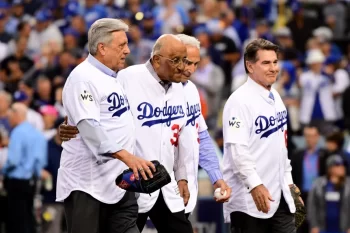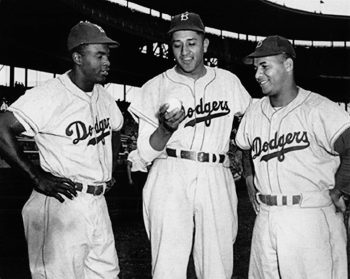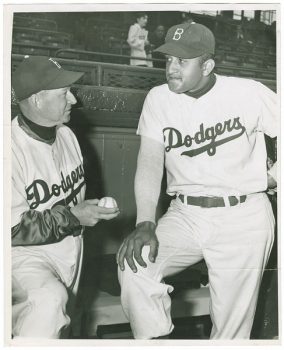Was Don Newcombe a Hall of Famer? – Spring means Baseball
 I have occasionally strayed off topic here at Black Gate, KISS, the Beach Boys, Humphrey Bogart…stuff like that. I played tee-ball as a tyke and have loved baseball my whole life. With a new season dawning (one in which my beloved Dodgers are the reigning World Series champs for the fourth time since I was born), I wanted to talk baseball. And I think that sharing about Don Newcombe is the way to do it.
I have occasionally strayed off topic here at Black Gate, KISS, the Beach Boys, Humphrey Bogart…stuff like that. I played tee-ball as a tyke and have loved baseball my whole life. With a new season dawning (one in which my beloved Dodgers are the reigning World Series champs for the fourth time since I was born), I wanted to talk baseball. And I think that sharing about Don Newcombe is the way to do it.
In 1949’s (sappy) It Happens Every Spring, Ray Milland’s chemistry professor suffers through his life half of the year, to get to baseball season.
Lord Tenneyson said ‘In the Spring a young man’s fancy lightly turns to thoughts of love.’ For a long time, it was baseball, not love, that young men thought of in American Spring.
When Spring Training would roll around in Florida (and then later, also in Arizona), I used to say “If they’re playing baseball somewhere, there’s till some hope for the world.” I’m not sure I believe that in these messed-up days. But the Dodgers (the epitome of a small-market, hard-working franchise, competing against big city, big money teams – HA HA HA) are working out and playing games in Arizona. It’s baseball season, which helps me ignore that my Ohio wind chill is 15 degrees right now.
The Dodgers and Yankees met in the World Series in 1947, 1949, 1952, 1953, 1955 and 1956. It was a glorious era for NYC baseball (and the Giants were a powerhouse as well), though Brooklyn managed to win only the 1955 matchup.
The greatest advantage that the Yankees had was their starting pitching. Whether it was Eddie Lopat, Allie Reynolds, Whitey Ford, Bob Kuzava or Don Larsen, the Bronx Bombers always seemed to come up with somebody in big moments (if not for Cookie Lavagetto, Bill Bevens would be included on that list).

During this era, Don Newcombe rose above other Dodger would-be aces such as Carl Erskine, Ralph Branca and Johnny Podres (though the latter certainly carried the flag in the 1955 Series). Big Newk missed the 1952 and 1953 seasons, as he was serving his country, fighting in Korea. And his 1954 season was a poor one: it took him a year to get back to form after being released from service.
But from 1949-1951 and 1955-1956, Newcombe went a combined 103-40, with 92 complete games. Those are some impressive numbers for the 1949 Rookie of the Year.
However, he got a reputation as a choker in big games. He went all ten innings against the Phillies on the final day of the 1950 season, with the Dodgers needing a win to force a playoff. But he gave up a three run homer to Dick Sisler in the top of the tenth in the season-ending 4-1 loss (which would have been a win if third base coach Milt Stock had simply held Cal Abrams at third in the bottom of the ninth).
He carried a 4-1 lead into the ninth inning of that famous game three playoff against the Giants in 1951. But he couldn’t hold on and he had been relieved by Ralph Branca when Bobby Thomson hit the home run heard round the world.
And in three World Series’, he just couldn’t get the job done for the Dodgers. He started 5 games, going 0-4 with an ERA of 8.59 and lasting about 4 innings a start. Dominating regular season, poor post-season: Shades of a great lefty named Clayton Kershaw, several decades and thousands of miles West, later (Kershaw is my second-favorite Dodger, after Jackie Robinson).
In 1956, he won the (very first) Cy Young Award and the NL MVP, going 27-7. But in the World Series he couldn’t make it out of the second inning of game two or the fourth in game seven. His drinking more directly impacting his performance, as well as his shoulder wearing out from the overuse, his career was effectively done, and he went a combined 37-42 in the four years after that Cy Young season.
He spent 1961 in the minors and he finished in Japan in 1962, as a first baseman. Newcombe was a career.268 batter, with 7 homers in 1955. He could have been a major league hitter.
A Trailblazer
 Newcombe was one of the first black players signed by the Dodgers. He and Roy Campanella played with Nashua of the New England League (B) in 1946. Newcombe returned there in 1947 (striking out 186), while Campanella played at AAA Montreal, and Jackie Robinson changed the world in Brooklyn.
Newcombe was one of the first black players signed by the Dodgers. He and Roy Campanella played with Nashua of the New England League (B) in 1946. Newcombe returned there in 1947 (striking out 186), while Campanella played at AAA Montreal, and Jackie Robinson changed the world in Brooklyn.
Newcombe was dominant in his two years at Nashua, going 33-10 with an ERA well under 3. He probably would have played in AA ball in 1947 but the Dodgers’ two AA teams were in the South and not yet ready to be integrated. Apparently AAA wasn’t the best option, as it had been for Robinson and Campanella.
In 1948 he went 17-6 at AAA Montreal (while Campy began his Hall of Fame career in Brooklyn). He threw his only no hitter, won three games in the first round of the International League Playoffs (losing another game 0-1), and then won a game in the Governor’s Cup series. He then went 1-1 as the Royals defeated the Dodgers’ other AAA team (St. Paul) for the Junior World Series. Newcombe dominated AAA.
He got called up to the Dodgers early in 1949. He was only the second black pitcher in the major leagues and the first good one (Dan Bankhead pitched in four games for the Dodgers in 1947).
Jackie Robinson deserves every praise and accolade. But Don Newcombe was the first man to prove an African-American could pitch in the major leagues. He hit 3 batters as a rookie, and 6 his third year. But there were no racial issues about a black pitcher hitting a white batter. It didn’t hurt that he was 6’-4”, 220. But his success, and his acceptance on the field, made him a pioneer, though he never received the credit he deserved for that.
Close to Cooperstown
 His raw numbers are lacking in HoF dazzle: 153-96, with a 3.57 ERA.
His raw numbers are lacking in HoF dazzle: 153-96, with a 3.57 ERA.
He does have one Rookie of the Year, one MVP, and one Cy Young award, along with one World Series ring, and he was a four-time All Star. That’s what is. But we can also look at a few ‘What ifs.’
There are four distinct elements of his career that might have changed his possible Hall of Fame path:
1) Newcombe’s first two seasons were spent with the Newark Eagles in the Negro Leagues. It’s fair to say that he might have developed more quickly with two years in the Dodgers’ system. But he was only 18 that first year. Maybe the hard experience of playing in the Negro Leagues had some benefits for him.
2) He lost a season, maybe two, to baseball’s color barrier. It’s a foregone conclusion that he would have done better than Dan Bankhead did. He was 17-8 with 19 complete games and a league-leading 5 shutouts as a 23 year-old rookie. That’s a pretty good start.
3) And he lost nearly two peak seasons to the Korean War. Plus his first year back was basically a lost one as well. He easily could have had three more 20 win/single-digit loss seasons.
Give him 60 more wins for the Korean War years, and there would be a dozen pitchers with fewer wins who are in the Hall of Fame, including two Dodgers (Don Drysdale, Dazzy Vance).
4) Finally, had Newcombe pitched better in the World Series (especially in 1956), he might well have continued on as one of the NL’s top pitchers, instead of spiraling deep into alcoholism.
With two more outs, it’s Newcombe, not Bobby Thomson, who is the hero of the 1951 NL playoff series (playoffs only occurred if two teams were tied at the end of the season. MLB did not adopt divisions and regular playoffs until 1969).
And with post-season success, the media might have lightened up (racism was certainly involved, but everyone loves a winner – somewhat). And he might have been more at ease if he wasn’t so clenched up inside from the criticism (Conversely, Newcombe was not appropriately praised for when he excelled, which he often did.).
That fourth factor (the postseason) was certainly within his control. But if the first three things had gone a bit differently, Don Newcombe might well be in the Hall of Fame today.
He and Justin Verlander are the only players to win the Rookie of the Year, Cy Young and MVP awards. That speaks volumes.
He Was Criticized Unjustly in the Press
 If you’ve read books about Jackie Robinson, you know the abuse that racist sportswriters (and fans, and players, and…) heaped upon him. Other early trailblazers like Newcombe were also the subject of vitriol. On September 14, 1951, Tommy Holmes of the Brooklyn Eagle – under the headline Is Newcombe Ailment a Case of Imaginatis? – wrote a scathing, rumor and innuendo-filled attack on Newcombe, which never would have been written about a white pitcher. Excerpts can be found in Jon Weisman’s book on Dodgers pitching, Brother in Arms. It’s a pathetic piece of non-objective ‘journalism’.
If you’ve read books about Jackie Robinson, you know the abuse that racist sportswriters (and fans, and players, and…) heaped upon him. Other early trailblazers like Newcombe were also the subject of vitriol. On September 14, 1951, Tommy Holmes of the Brooklyn Eagle – under the headline Is Newcombe Ailment a Case of Imaginatis? – wrote a scathing, rumor and innuendo-filled attack on Newcombe, which never would have been written about a white pitcher. Excerpts can be found in Jon Weisman’s book on Dodgers pitching, Brother in Arms. It’s a pathetic piece of non-objective ‘journalism’.
For example, Holmes asserts that ‘experts’ expected Newcombe to win 30 games that season, and instead of doing so, he was complaining about a sore arm. Dizzy Dean won 30 games in 1934. Exactly one pitcher has done so (that’s a good trivia question – go look it up) in the 90 seasons since. Holmes wrote an ‘uppity negro’ piece on Newcombe, and it was wrong in EVERY way.
As Chuck Dressen desperately tried to stop the Dodgers’ epic collapse (they led by 13 games in August), he kept throwing a tired (Newk led the team in innings pitched and had 18 complete games) and sore-armed Newcombe out there.
Newcombe started on September 17th, lasting only 6 and two-thirds. On the 22nd, he only made it 5 innings. On the 26h, he threw a complete game in a 15-5 win (you think Dressen couldn’t have given him a few innings off in a ten run win?). Only three days later on the 29th, it was a complete game shutout. And the very next day in the must-win season-finale, Dressen had him pitch 5 and two-thirds innings of relief. Big Newk gave up one hit and no runs as the Dodgers won 9-8, forcing the three-game playoff that made Bobby Thomson a baseball legend.
On only two days rest, after that heavy workload, Newcombe pitched 8 and one-third innings in that third-game loss. He had performed an even more impressive feat of carrying the team to the final day of the season the year before.
Holmes and other writers (and NYC baseball writers were celebrities in their day) wrote about Newcombe from their racist beliefs, not as objective observers. He was a workhorse who carried Dodgers teams to the brink of championships.
Alcoholism and Rebirth
Newcombe succumbed to life-long alcoholism. While he made the choice to drink, the unrelenting (and unreasonable) pressure he was subjected to, along with racist abuse, surely contributed to its severity. He declared bankruptcy in 1965 (he sold his World Series ring, which future Dodgers owner Peter O’Malley later bought and returned to him), and later divorced.
But he stopped drinking, straightened out his life, and was the Dodgers’ Director of Community Relations for over forty-five years, passing away in 2019. He became a leader in several organizations inside and outside of baseball, related to beating alcoholism.
Newcombe reflected on his career being cut short:
“I was only 34, but the alcohol had taken its toll. I think it shortened my major-league career by about six or seven years. I regret that I didn’t take better care of myself in the latter part of my career because I would like to have made the Hall of Fame, where I think I belong.”
Don Newcombe was haunted by his own demons, but found his own personal redemption. And with better handling on the Dodgers’ part; a few more seasons in the majors; and some more self-control, he could well be in Cooperstown today.
Newcombe recounted a conversation he had with Martin Luther King Jr.:
“Do you want to know what Jackie’s impact was? Well, let Martin Luther King tell you. In 1968, Martin had dinner in my house with my family. This was 28 days before he was assassinated. He said to me, ‘Don, I don’t know what I would have done without you guys setting up the minds for people for change. You, Jackie (Robinson) and Roy (Campanella) will never know how easy you made it for me to do my job.’ Can you imagine that? How easy we made it for Martin Luther King?”
He was an under-appreciated trailblazer, who rewrote his own personal story and played a major part in Dodgers’ history, on and off the field. And he wasn’t as far from a Hall of Fame career as one might think. It’s a shame no one worked with him to write a biography. It would have been a terrific book. He passed in 2019.

Bob Byrne’s ‘A (Black) Gat in the Hand’ made its Black Gate debut in 2018 and has returned every summer since.
His ‘The Public Life of Sherlock Holmes’ column ran every Monday morning at Black Gate from March, 2014 through March, 2017. And he irregularly posts on Rex Stout’s gargantuan detective in ‘Nero Wolfe’s Brownstone.’ He is a member of the Praed Street Irregulars, founded www.SolarPons.com (the only website dedicated to the ‘Sherlock Holmes of Praed Street’).
He organized Black Gate’s award-nominated ‘Discovering Robert E. Howard’ series, as well as the award-winning ‘Hither Came Conan’ series. Which is now part of THE Definitive guide to Conan. He also organized 2023’s ‘Talking Tolkien.’
He has contributed stories to The MX Book of New Sherlock Holmes Stories — Parts III, IV, V, VI, XXI, and XXXIII.
He has written introductions for Steeger Books, and appeared in several magazines, including Black Mask, Sherlock Holmes Mystery Magazine, The Strand Magazine, and Sherlock Magazine.
Career wasn’t long enough. His peak was HOF-worthy, but wasn’t extended enough. To be sure, he lost two years in the military.
Yeah. The two Korean War years, and the year after (which was pretty bad) definitely derailed him some.
If he’d won Brooklyn a World Series against the Yanks, he’d been beloved in Brooklyn, like Podres was. Tough break.
I would guess that the shortness of his career, along with the notable fatigue-based shortcomings in the late season, would be heavy burdens to Mr. Newcombe getting his HoF plaque. Baseball Reference lists Schoolboy Rowe (158-101), Jered Weaver (150-98), and Roy Oswalt (163-102) as the most comparable pitchers to Mr. Newcombe.
The Society for American Baseball Research (SABR) has a nice biography webpage for Mr. Newcombe: https://sabr.org/bioproj/person/don-newcombe/. It mentions that after his MLB career ended in 1960, he played in Japan, primarily as a first baseman, thanks to his hitting prowess(!).
And one “secret” to my success in fantasy baseball was always drafting Clay Kershaw with my first pick. It took 4 seasons (2013-2016) before the rest of the league could snatch him from me.
SABR is literally my favorite baseball site. I have been a member in the past. I have several of their books – paperback, and digital. SABR and the Baseball Reference website are two absolute treasures for me.
The ‘Memorable Baseball Teams’ series is a total geek delight. The one on the 1947 Dodgers is one of my favorite books.
https://www.amazon.com/Team-Forever-Changed-Baseball-America/dp/0803239920/ref=sr_1_1?crid=30EDTFQOYSZHC&dib=eyJ2IjoiMSJ9.ui4veun6OtEnDL6R90ZHEdZlOUDRKTQNtJQNiDOq-CRkFPNYjlBBtkoiMqq6ge72.5iNpNSD5LOODqziJBrDUZgUGUOKWosagt8yoXt7OXLw&dib_tag=se&keywords=The+Team+That+Forever+Changed+Baseball+and+America%3A+The+1947+Brooklyn+Dodgers&qid=1741178476&s=books&sprefix=the+team+that